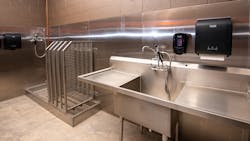Station Design Conference Evolves with Current Trends
Do you know of a firefighter who was diagnosed with cancer? What about a fire department that has suffered the loss of a firefighter to suicide? Too many of us do. Raising awareness to improve the physical and mental health of firefighters and emergency medical personnel is more than a just trend. Following the research on physical and mental health issues, architects who specialize in designing fire, EMS and law enforcement facilities are interpretting the research into building designs. And it’s time.
In 2015, during the Firehouse Station Design Conference, the Hot Zone design concept to contain cancer-causing contaminants in fire stations, was introduced by Paul Erickson, FAIA, LeMay Erickson Wilcox Architects. Since that time, the Hot Zone design or elements were quickly incorporated into new fire station designs. (Not unlike the dramatic fire apparatus design changes five years after a Massachusetts firefighter fell from a fire truck. The subsequent 1986 lawsuit resulted in important changes in fire trucks to include fully-enclosed cabs and seatbelts for every member of the crew.)
Among the 30-plus presentations in the 2022 Station Design Conference, May 24-26 in Rosemont, IL several focus on the reduction of firefighter exposures to carcinogens in the fire station. Increased efforts to contain exposures have recently evolved to onsite procedures to remove and bag turnout gear to reduce transport back to the station.
Red/Yellow/Green: Design for Exposure Reduction and Contaminant Control, presented by Katie Atwater, AIA, and Christopher Kehde, AIA, LeMay Erickson Willcox Architects, will focus on recent updates to the Hot Zone design principles. Atwater and Kehde will include recent updates to NFPA standards, examples of how to customize for each department’s health-safety goals and highlight lessons learned through case studies.
Precautions continue when an incident’s contaminated turnout gear is brought back to the fire station. The importance of designing a decon laundry facility that is compliant with NFPA 1851 guidelines is presented by Robert Mitchell, AIA, Mitchell Associates Architects. In Build an Effective Decon Laundry Sector in your Station, Mitchell explores what spaces are needed and common design mistakes to avoid. As research continues to reveal further understanding of cancer in firefighters, he shares the emerging ideas not yet incorporated in the standards that should become a critical part of a fire station design.
One other concern in the physical and mental health of first responders, is sleep deprivation and the impact of 24- or 48- hour shift schedules. Craig Carter, AIA, BKV Group has followed the loss of sleep and health, and ultimately safety, of firefighters and EMS personnel. In Solving Sleep Deprivation for First Responders, Carter shares the health and behavior implications of sleep deprivation and offers elements of station design that can help and the policy changes needed to alleviate sleep deprivation.
Last year, according to an article from Kansas Today, a team of investigators at the University of Kansas collected data for ways to improve the quality of sleep for firefighters and paramedics in the Lawrence Douglas County Fire-Medical Department. Better sleep could improve first responders’ physical and quick decision making in the stressful work encountered in life-and-death situations. In the report, Nancy Hamilton, associate professor of social and behavioral sciences and psychology at KU, wrote, “Because firefighters and paramedics have sleeping quarters at the workplace, they experience a sleep environment different from most people, with less control over light, noise and bedding — and with sleep often interrupted to rush to an emergency situation.”
Acknowledging the increase of Post-Traumatic Stress Disorder (PTSD) within all emergency services, the topic of mental health and recent research on designs medical facilities use to reduce stress, will be included in other conference programs
In 2014, with the first Firehouse Station Design Conference, the focus was primarily on site station location selection and the basics of fire station design and construction. Over years, the conference program has grown and evolved. The 2022 conference begins with an overview of the design process, through operations of a fire, EMS, or a shared first responder facility, but among four tracks, the topics quickly expand to cover trends, innovations, and updates on new construction materials to extend the use of the building beyond 50 years and much more.
About the Author
Janet A. Wilmoth
Special Projects Director
Janet Wilmoth grew up in a family of firefighters in a suburb of Chicago. Wilmoth, who is owner of Wilmoth Associates, worked with Fire Chief magazine for 27 years until it closed in 2013. She currently is the project director for Firehouse, overseeing the Station Design Conference.

